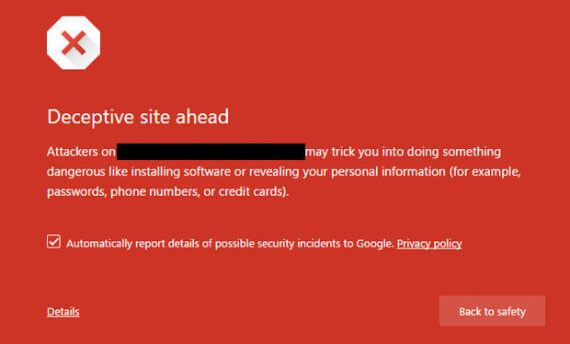
Common Causes of Website Downtime
There’s nothing more frustrating than a website crash if you don’t know the cause of it. When your business income depends on website uptime, downtime can feel like a ticking clock.
But why is your website down? What can you do to get it going again?
Website crashes are nothing new. We’ve seen some of the web’s biggest websites break. Outages are inevitable. But prolonged site downtime is not necessary.
Here are a few common causes of a website crash, and some suggestions for getting it back up again. We’ve also included some helpful preventative maintenance ideas to keep you from being surprised by a crash.
Table of Contents
- Website Crash #1: Expired Domains
- Website Crash #2: Malicious Attacks
- Website Crash #3: Google Blacklisting
- Website Crash #4: Traffic Surges
- Website Crash #5: Domain/Hosting Provider Error
- Website Crash #6: Coding Issues
- Website Crash #7: Plugin Issues
- Website Crash #8: DNS Errors
- Be Proactive By Monitoring Your Domain
Website Crash #1: Expired Domains
Failing to renew your domain is a simple oversight. Domain registration is a separate service from web hosting, and while your hosting plan may still be intact, your domain can still expire and take down your website.
Corrective Action: Login to your hosting account, renew your domain and check website status.
Prevention: Set up a WHOIS/Domain Expiry check to remind you at least 20 days before expiration. You’ll receive an alert when your expiration date is near so you can take care of it.
Pro tip: Integrate your check with the push notification services you use most. Emails and calendar updates are easy to lose.
Website Crash #2: Malicious Attacks
Hackers are always looking for unsecured domains to launch attacks from. They can collect user data, test exploits, and collect valuable data about attacks from probing websites that don’t appear to be ideal targets. Not only can these attacks take down your website, they can land you on various blacklists that prevent emails from going through and hurt search traffic.
Corrective Action: Secure your website. WordPress websites are notorious for spam comments that can crash both websites and email accounts, so turn off commenting if you don’t need it. Don’t allow users to register on your site (if you don’t need it), and keep your software and plugins updated. Don’t forget to keep a backup of your most stable installations so you can revert to a working version in case you get stuck with no other solution.
Prevention: Be proactive about scanning your site for viruses and malware that could ruin your reputation. Create a Virus/Malware check that scans your domain daily for issues.
Website Crash #3: Google Blacklisting
Technically not an outage or crash, but Google Blacklisting can still cripple a website. If Google detects problems with your site, visitors to your domain see a screen that warns them of issues and blocks your homepage.

Though visitors can still navigate to your site if they know which links to click, most will go elsewhere.
Corrective Action: Read the error code on the page to find out why Google is blacklisting the site and make corrections. If you’re still unsure, a Domain Health check tests for multiple issues and will let you know what the problem is.
Prevention: Setting up multiple checks will keep you informed of problems as they happen. Correct issues quickly so your site can stay in Google’s good graces. The Domain Health Check allows users to check website status for issues including SSL, DNS and Malware/Viruses in seconds.
Website Crash #4: Traffic Surges
Enterprise IT will always try to maximize resource allocation, and occasional traffic surges can cause downtime. You can estimate to the best of your team’s abilities, but you never really know the effect of a sale or the volume of traffic you’ll get. .
Unless you’re the victim of a DDoS attack, the solution is to scale your resources according to your needs.
Corrective Action: Upgrade your hosting plan.
Prevention: To prevent these issues from happening, keep an eye on your web traffic. Switch plans when your site is reaching the upper end of your current plan. Also, learn how to prepare your site for traffic surges by using a CDN and other preventative measures.
Website Crash #5: Domain/Hosting Provider Error
A good hosting provider constantly monitors uptime, especially since many of them guarantee a high percentage of website uptime. But even good hosts have bad days.
Corrective Action: Overheated equipment, bad weather or configuration errors can all cause websites to crash. These issues are out of your control so there’s nothing you can do to fix them. Your hosting provider should reach out if major outages occur and tell you what they are doing (or did) to correct it.
Prevention: Having a good, reliable host is the only way to avoid a problem like this. Instead of purchasing a plan solely on price, read reviews and check with others to find a provider with the right mix of value and reliability.
Website Crash #6: Coding Issues
Nothing is more delicate than code (at least in the digital world). A single coding error can take down an entire website. Clean code improves loading times, so it’s obvious that the opposite can significantly bog down your page speed even if it doesn’t crash your site.
Corrective Action: Fixing this problem can be extremely difficult, depending on where the coding error lies. A professional developer can troubleshoot your site for broken code. If you just deployed updates to your website, that would be the place to start.
Prevention: Invest in development. Stay away from free or outdated WordPress themes, and have a professional review everything if they aren’t creating from scratch.
Website Crash #7: Plugin Issues
Plugins are an easy way to add functionality to a site without having to rework code. There are over 54,000 plugins currently available in the WordPress database. Though these mini-apps provide a convenient way to do things without programming knowledge, that convenience comes at a price.
Corrective Action: If you suspect a plugin is causing your website to crash, start by disabling the most recent one until your website is up and running again. Sometimes certain plugins are not compatible with each other, and you’ll have to decide which ones you can’t live without.
Prevention: To prevent plugin issues from crashing your website, use as few as possible. Keep them updated, and when you update WordPress make sure your plugins are compatible with the new version. Run a Page Speed Test to catch plugin issues before they take down your site.
Website Crash #8: DNS Errors
DNS is the way computers find your site on the internet. DNS errors are difficult to pinpoint, but usually simple to solve.
Sometimes DNS record errors can be a sign of a malicious attack.
Corrective Action: First, check with your hosting provider to see if they’ve made any changes. Sometimes these take time to update and there really isn’t a problem to fix.
Next, check your nameservers to make sure they’re pointing to the right place. If you’ve recently changed hosts, this could be the issue. An expired domain can also cause this problem.
Once you pinpoint the problem, make the necessary changes.
Prevention: Prevent DNS record issues from taking down your site by setting up a DNS Server check.
Be Proactive By Monitoring Your Domain
A website crash doesn’t have to devastate your business. Stay on top of issues as they happen by using a web monitoring service. Uptime.com provides a variety of checks to make sure you’re aware of any issues related to your domain immediately.
Correct problems sooner than later by continually monitoring your domain and website uptime.
Minute-by-minute Uptime checks.
Start your 14-day free trial with no credit card required at Uptime.com.
 Uptime.com Blog
Uptime.com Blog


